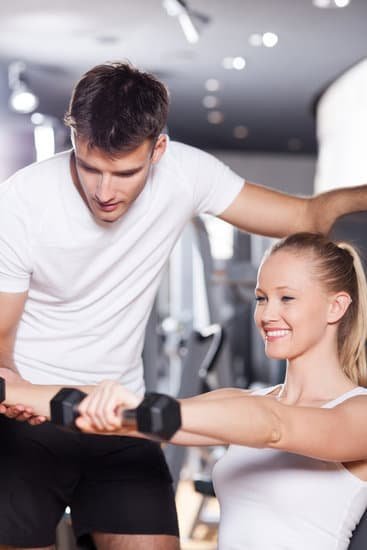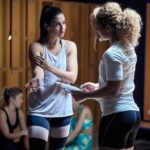Are you wondering how to plan a fitness routine for middle school students? Physical activity is crucial for the overall development of middle schoolers, and creating a fitness routine can help them establish healthy habits early on. In this article, we will explore the importance of physical activity for middle schoolers and discuss how to plan an effective fitness routine tailored to their needs.
Assessing individual fitness levels is an important first step in planning a fitness routine for middle schoolers. Understanding where they currently stand in terms of physical fitness will help determine the starting point and set realistic goals. We will delve into the process of assessing individual fitness levels and provide guidance on establishing achievable objectives.
Once the starting point and goals are determined, it’s vital to choose the right activities for the fitness routine. Middle schoolers have various options when it comes to physical activities, and we will explore different options that cater to their interests and abilities. Additionally, we’ll discuss how to create a schedule that balances fitness with academic responsibilities and other extracurricular activities, as well as the importance of adult guidance and peer support in maintaining the routine.
Assessing Individual Fitness Levels
Evaluating Physical Abilities
One way to determine the starting point for a fitness routine is to evaluate the physical abilities of the students. This can include assessing their cardiovascular endurance, muscular strength, flexibility, and body composition. Simple exercises like timed laps around the track, sit-ups, push-ups, and stretches can give insight into where each student stands in terms of physical fitness.
Identifying Interests and Preferences
Another aspect of assessing individual fitness levels is identifying the interests and preferences of the students. Some may enjoy team sports, while others may prefer individual activities like swimming or dance. By understanding what types of physical activity they enjoy, educators can tailor a fitness routine that will not only improve their overall health but also be enjoyable for them.
Consultation With Health Professionals
In some cases, it may be necessary to consult with health professionals such as physical education teachers or doctors to gather more information about the students’ fitness levels. This can provide valuable insights into any underlying health conditions or specific needs that should be considered when planning a fitness routine for middle schoolers.
By taking the time to assess individual fitness levels through evaluation of physical abilities, identifying interests and preferences, and consulting with health professionals when necessary, educators can create a tailored and effective fitness routine for middle schoolers that will set them up for success in their health and wellness journey.
Setting Fitness Goals
When planning a fitness routine for middle schoolers, it is essential to start by setting achievable and realistic fitness goals. This will not only help in keeping the students motivated but also ensure that they are progressing in a safe and healthy way. Here are some tips on how to set the right fitness goals for middle schoolers:
1. Identify specific goals: Start by identifying what the middle schooler wants to achieve through their fitness routine. Do they want to improve their endurance, build strength, or simply lead a healthier lifestyle? By setting specific goals, it becomes easier to track progress and stay focused on achieving them.
2. Make goals measurable: It’s important that the fitness goals are measurable so that progress can be tracked effectively. For example, instead of setting a goal like “improve endurance,” make it more specific such as “run a mile without stopping within 8 minutes” or “do 10 push-ups without taking a break.”
3. Set realistic timelines: While it’s important to challenge oneself, it’s equally crucial to set realistic timelines for achieving the set fitness goals. Middle schoolers should understand that significant improvements take time and consistency, and they should not expect overnight results.
By incorporating these tips into the goal-setting process, middle schoolers can develop a clear understanding of what they want to achieve from their fitness routine while also ensuring that the objectives are attainable with consistent effort.
Overall, setting realistic and achievable objectives is foundational when planning a fitness routine for middle schoolers. It sets the stage for progress tracking and makes the journey towards better physical health both challenging and rewarding.
Choosing the Right Activities
When it comes to planning a fitness routine for middle schoolers, it’s essential to choose activities that are both enjoyable and beneficial for their physical development. Middle school students are at an age where they are exploring different sports and physical activities, so it’s important to offer a variety of options to keep them engaged. Here are some popular and effective activities to consider when planning a fitness routine for middle schoolers.
Team Sports
Team sports like basketball, soccer, and volleyball are great options for middle schoolers as they not only provide physical exercise but also teach important skills like teamwork, communication, and sportsmanship. These activities can be offered through the school’s sports program or local community organizations.
Dance and Aerobics
For students who enjoy music and movement, dance and aerobics classes can be a fun way to get active. These types of activities improve cardiovascular health, coordination, and flexibility while allowing students to express themselves creatively.
Strength Training
While some may think that strength training is only for adults, it can actually be beneficial for middle schoolers as well. Using bodyweight exercises or light weights under supervision can help improve muscle strength and endurance, which is important for overall physical development.
By offering a mix of these different activities, students can explore their interests and find what works best for them. It’s important to create a well-rounded fitness routine that includes a variety of exercises to target different aspects of physical health. This approach will not only keep middle schoolers engaged but also ensure that they are getting the most out of their fitness routine.
Creating a Schedule
Creating a fitness routine for middle schoolers involves more than just choosing the right activities and setting goals. It also requires careful planning to ensure that physical activity is balanced with academic responsibilities and other extracurricular activities. Here are some tips on how to create a schedule that allows middle schoolers to prioritize their fitness while managing their other commitments.
First, it’s important to set realistic expectations for the amount of time that can be dedicated to fitness each week. Middle schoolers have busy schedules, so it’s essential to find a balance that works for them. This might mean scheduling shorter, more frequent workouts or finding ways to incorporate physical activity into daily routines, such as walking or biking to school.
It’s also crucial to involve the middle schooler in the scheduling process. By allowing them to have a say in when and how they will engage in physical activity, they are more likely to take ownership of their fitness routine. This can help them develop time management skills and a sense of responsibility for their own health and well-being.
Additionally, parents and teachers can play a crucial role in supporting middle schoolers as they navigate their various commitments. By providing guidance on time management and helping them prioritize their activities, adults can help ensure that fitness remains a consistent part of the middle schooler’s routine.
Finally, monitoring progress and making adjustments as needed is essential for maintaining motivation and ensuring continued success in sticking with a fitness routine. By taking these steps, middle schoolers can develop healthy habits that will benefit them throughout their lives.
Finding Support
Middle school can be a challenging time for students, as they navigate through the physical and emotional changes that come with adolescence. This is also an important time to establish healthy habits, including regular physical activity.
However, it can be difficult for middle schoolers to stay motivated and committed to a fitness routine without the support of adults and peers. Finding support from adults such as parents, coaches, or teachers can make a significant difference in a student’s willingness to engage in physical activity.
Adults can provide guidance on how to plan a fitness routine that is safe and appropriate for the student’s age and fitness level. They can also offer encouragement, motivation, and accountability. Whether it’s participating in sports teams, joining after-school fitness classes, or simply going for walks together, having adults actively involved in a middle schooler’s fitness journey can greatly contribute to their success.
In addition to adult support, peer encouragement is also crucial for middle schoolers when it comes to staying active. Having friends who share similar fitness goals can create a sense of camaraderie and make exercising more enjoyable. Engaging in group activities such as team sports or group workouts can foster a positive environment where students feel supported by their peers.
It’s important for parents and educators to recognize the role they play in fostering an environment that promotes physical activity among middle schoolers. By providing guidance and encouragement, as well as creating opportunities for social interaction around exercise, adults can help students develop a lifelong commitment to maintaining their health and well-being through regular physical activity.
| Support | Importance |
|---|---|
| Adults | Provide guidance on planning a safe routine |
| Peer Encouragement | Create camaraderie and enjoyable exercise experiences |
Monitoring Progress
Once a fitness routine has been established for middle schoolers, it’s essential to monitor progress and make any necessary adjustments. Tracking improvements not only shows the effectiveness of the routine but also provides motivation and reinforcement for the students. Here are some effective ways to monitor progress and make necessary adjustments:
One way to track improvement is through regular fitness assessments. These can include measurements of strength, endurance, flexibility, and cardiovascular fitness. By conducting these assessments at regular intervals, students can see how their hard work is paying off and where they may need to focus more attention.
Another method of monitoring progress is by keeping a fitness journal or log. Encourage middle schoolers to record their workouts, noting the exercises they did, the number of repetitions or duration, and any thoughts or feelings about the workout. This can help them see patterns in their performance and identify areas that may need improvement.
It’s important to note that making necessary adjustments to a fitness routine doesn’t always mean increasing intensity or duration. Sometimes it may be necessary to scale back certain activities if they are causing pain or discomfort. Additionally, as students’ interests change, it may be necessary to introduce new activities into the routine to keep them engaged and motivated.
By tracking improvements and making necessary adjustments, middle schoolers can continue on their path toward physical health and wellness, setting them up for a lifetime of good habits.
| Tracking Improvements | Making Necessary Adjustments |
|---|---|
| Regular fitness assessments | Fitness journal or log |
| Identifying areas for improvement | Introducing new activities |
Adapting the Routine
When it comes to planning a fitness routine for middle schoolers, it’s important to recognize that each student has individual needs and preferences. Not every activity or schedule will work for every student, so it’s crucial to be adaptable in the approach to physical fitness. Making modifications based on these individual factors can help ensure that the fitness routine is enjoyable, sustainable, and effective for each middle schooler.
One way to adapt the fitness routine is by taking into account any physical limitations or health concerns that a student may have. For example, if a student has asthma, high-impact activities like running may not be suitable for them. In this case, modifications could include incorporating low-impact exercises such as swimming or cycling into the routine. By being mindful of each student’s unique needs, the fitness routine can be tailored to accommodate everyone.
In addition to physical considerations, it’s important to also take into account the personal preferences of the middle schoolers when planning a fitness routine. Some students may prefer team sports, while others may enjoy solo activities like yoga or dance.
By offering a variety of options and allowing students to choose activities that they genuinely enjoy, they are more likely to stay engaged and committed to their fitness routine. This adaptability helps foster a positive attitude towards exercise and encourages a lifelong commitment to physical activity.
Overall, by making modifications based on individual needs and preferences, the fitness routine can be personalized and inclusive for all middle schoolers. This approach promotes an environment where every student feels supported and motivated to participate in physical activity while recognizing their unique circumstances and interests.
Conclusion
In conclusion, establishing a fitness routine for middle schoolers can play a crucial role in promoting a lifelong commitment to physical activity and overall health. By understanding the individual fitness levels of students, setting realistic goals, and choosing suitable activities, educators and parents can effectively support their young learners in developing a sustainable fitness routine.
Finding the right balance between schoolwork, extracurricular activities, and physical fitness is essential for middle schoolers. Creating a schedule that allows for regular exercise without compromising academic responsibilities is key. With the proper guidance from adults and encouragement from peers, students can navigate their daily routines with greater ease.
Monitoring progress and making necessary adjustments along the way are fundamental aspects of maintaining a successful fitness routine. As students experience improvements in their physical capabilities, they will be motivated to continue their journey towards better health. Ultimately, by instilling these habits early on, educators and parents can help foster an enduring commitment to physical fitness in middle schoolers that will benefit them well into adulthood.

Passionate about providing useful information to anyone with an interest in the field of Personal Training, I strive to pass on to our readers quality information and to answer any questions about Personal Trainers, the work they do and how to become one.





